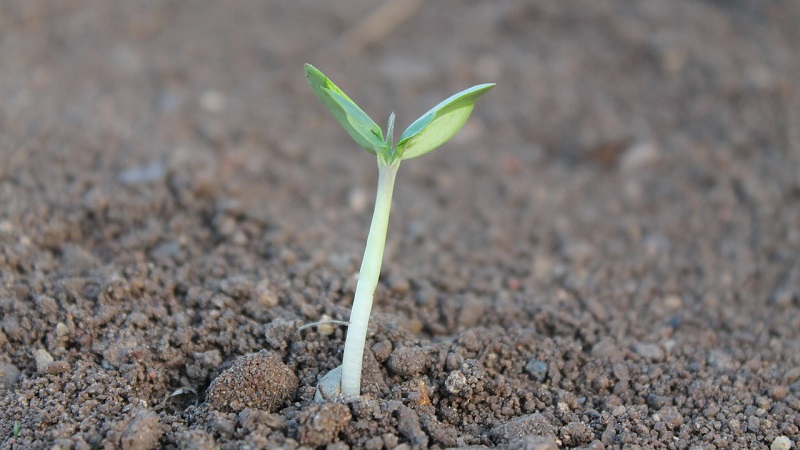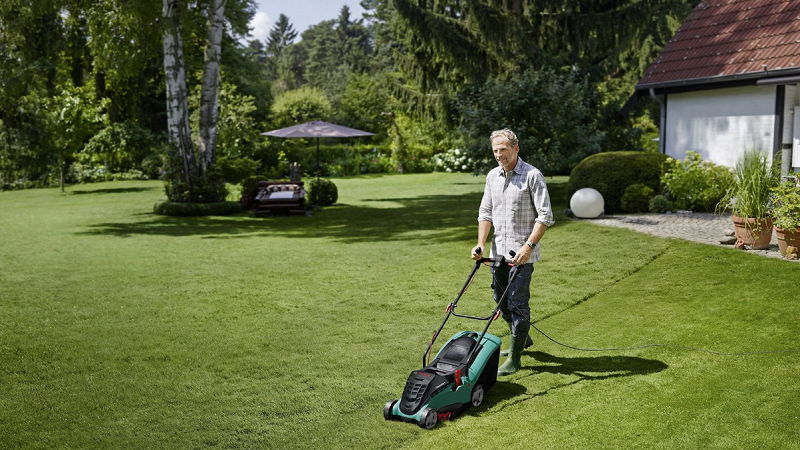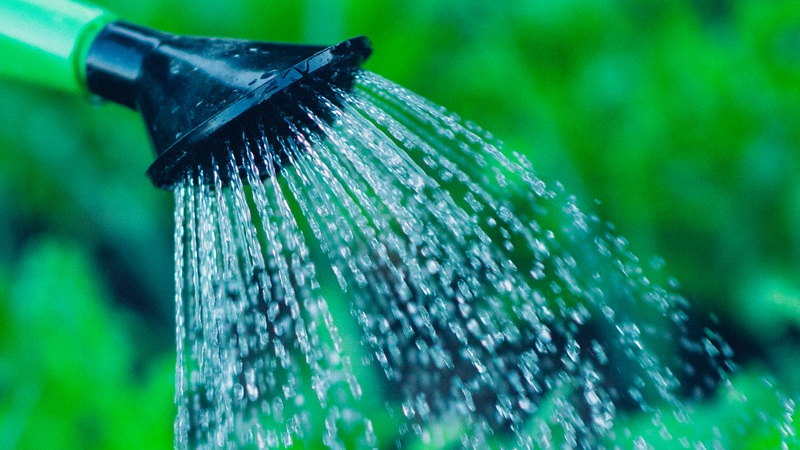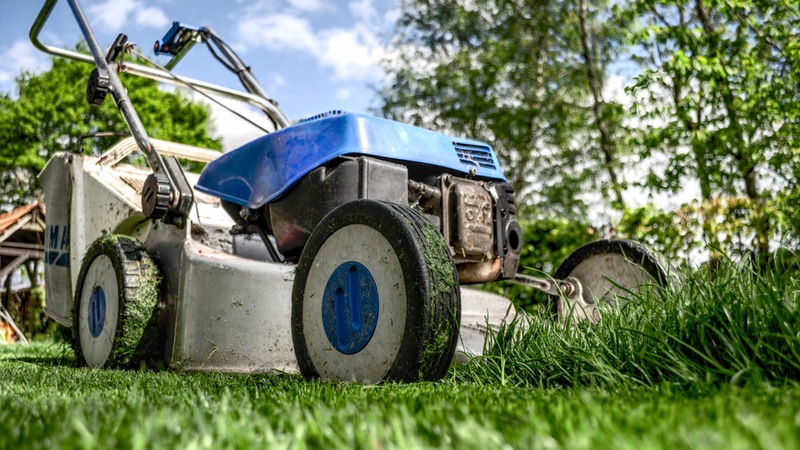Having a well manicured lawn can take a lot of work, but it’s worth it. A good lawn improves your home’s curb appeal and actually increases the value of your property. It also makes your garden space more inviting, useful and enjoyable for you.
A well maintained lawn reduces the amount of dust and dirt that is tracked into the house. It also buffers street noise and helps prevent soil erosion, as well as the erosion of friendly relations with your neighbours!
A beautiful lawn welcomes you home at the end of the day and gives you a place to relax and unwind at the weekend. In this article, we will share the basics of establishing and caring for a healthy lawn. Read on to learn more.

1. Begin with a good plan
A well planned lawn acts as a backdrop for a beautiful garden or landscape. As you plan your lawn areas, there are a number of things you should keep in mind, including:
- The activities you wish to enjoy on your lawn
- The level of maintenance to which you can commit
- The types of plantings you wish to include in your garden
- The amount of water and money you will be able to invest
By honestly examining your own wishes, intentions, resources and abilities, you can establish a practical plan that realistically lays out your own investment. Good planning helps you avoid wasting money on unnecessary purchases and hit-and-miss experimentation.
BONUS TIP: It’s best if you can begin your lawn project in the autumn to allow your amendments and preparations to take effect before you add seed or sod in the springtime.
2. Evaluate & prepare your soil
With a firm plan in place, start your lawn project by getting to know your soil. Begin with a soil test which will help you determine both the nutrient makeup and the texture of your soil. You can conduct this yourself using a soil test kit purchased from your local garden center.
Alternatively, you may be able to send your soil samples off for professional evaluation via online services. Either way, be sure to collect your samples from various areas of your garden. This will provide the best chance of honest and thorough evaluation.

3. Weed your lawn
Before you begin adding new grass, remove existing undesirable plants. You can weed by hand and/or use herbicides to kill off weeds. If you do not want to use chemicals on your lawn, you can use straight, white vinegar as an herbicide. Just spray it carefully onto the weeds you wish to kill, early in the morning on a clear, still day. The combination of hot sun and vinegar will kill off most weeds within 24 hours.
4. Deal with insects & pests
Identify any problems you may have with pests such as grasshoppers, moles and other undesirables. Take any necessary steps to deal with these before adding new grass.
5. Amend your soil
When you have identified the needs of your soil, you can make amendments in a wise and thrifty manner. Commercial additives, such as:
- Phosphorous
- Potassium
- Lime
…can be spread over the surface of the soil and watered in. It is also a good idea to till in some aged organic manure or compost made using your own garden clippings and kitchen scraps. Properly mixed and aged compost provides a wealth of nutrients for lawn care and general garden use. Water after tilling these amendments into your soil.
Alternatively, plan your additions well and make them prior to anticipated rain.
6. Cultivate your grass
If you have an existing lawn, identify the type(s) of grass present and decide whether or not you want to keep them. If you have a desirable type of grass present, you should keep it in place and take steps to help it thrive.
Healthy grass that is already established is a bonus and a valuable resource as it can save you time and money in terms of planting and care costs. Additionally, a healthy, well-established lawn will fight back weeds.
Think also about any bumps you need to level or any other areas you need to fix.

7. Choose the best grass for your setting
If you must replace or add to your lawn, determine which type of grass you want.
Common grass types in the UK
- Dwarf Ryegrass (aka: Turf Ryegrass, Lolium perenne) prefers moist soil and full sun. This perennial grass has a short growth period and produces a greater number of grass shoots than some varieties. It establishes itself quickly and easily and produces a thick lawn.
- Red Fescue (aka: Festuca Rubra) can thrive in dry, shady areas and can withstand a lot of foot traffic. It is a popular choice in resorts and camping areas. This grass is drought resistant and very low maintenance. It can take a while to germinate and establish itself. It is often used in combination with a sun-loving grass for full coverage.
- Slender Creeping Red Fescue (aka: Festuca Rubra Litoralis) is quite easy to grow, rugged and good looking. It can withstand cold, wet weather conditions; however, it is happiest in well-drained soil with regular, weekly watering. It is a good choice for shady conditions and does not do well in full sun or in drought conditions.
- Common Bent (Agrostis Capillaris L) has a number of common names, including Highland Bent, Fine Bent, Brown Bent and Colonial Bent. It is a perennial grass which develops strong, thick rhizomes or roots. It does quite well across a variety of terrains, including pastures, meadows, acidic grassland, rough ground and/or damp soil. It thrives in even very poor soil conditions and germinates twice a year (spring and fall).
- Smooth-stalked Meadow Grass (aka: Poa Pratensis or Kentucky Bluegrass) is a very durable grass in a striking shade of dark green. The leaves are broad, and the root system is extensive. These traits make this grass very resistant to drought. This type of grass is also very full of nutrients, so it’s great for grazing animals, both wild and domestic. It’s a good choice for a wildlife-friendly country garden.
- Annual Meadow Grass (aka: Poa Anua) is a popular choice for high traffic areas, such as bowling greens and golf courses. It is especially suited to these areas because it flowers all year round and its seeds are easily spread by foot traffic, so re-seeding is automatic. This is a high maintenance grass that is not drought resistant and has very specific soil requirements. It will not do well in a low phosphate or high acid soil.
To determine which type(s) of grass will work best in your setting, you must study the course of the sun across your property, consider typical weather conditions and think about the amount of care, watering and fertilising you wish to provide.
8. Decide whether you want to use seed or sod
You will also need to decide whether you want to sow seed or lay down sod. Seed is less costly, but it takes a certain amount of skill to sow it evenly, care for it properly and ensure that it thrives. Still, if you have a fairly decent lawn in place, sowing seed to thicken it and fill in any bare spots is the way to go.
If you are just filling in bare patches and thickening an existing lawn, you can hand sow the seed. If you are starting a whole new lawn, use a rotary fertiliser spreader to sow a mixture of seed and sand. Mulch lightly over the freshly sown seed to help it stay in place and prevent birds eating it.
BONUS TIP: Wear golf shoes or soccer cleats when sowing grass seed, mowing and caring for your new lawn. Walking over your lawn in this type of shoe protects the surface and helps aerate the soil.
Buying sod is more costly, and it should be installed by a professional. If you decide to purchase sod to establish your yard, you must find a reputable supplier who provides sod that is guaranteed to be free of weeds and pests.
To lay sod successfully, your ground must be properly prepared, and the sod must be laid in such a way as to maximize root contact with the soil. Failure in any one of these aspects of sod selection and installation will result in failure to thrive and a complete waste of money and effort on your part.
If you try to do this job yourself and fail, you will have lost a considerable amount of money. If you hire a professional and something goes wrong, you will have a guarantee to fall back on.
9. Provide your newly-laid lawn with proper care
Whether you choose seed or sod, you must care for your burgeoning young grass carefully and consistently. It’s a good idea to set out your seed or sod just before a predicted rain. Otherwise, water lightly before sowing seed or laying out sod and follow up with a deep, gentle watering.
Keep the area lightly moist until your new grass is established. Allow the grass to grow just a bit shaggy before the first mowing. Don’t forget to use lawn rakers or scarifiers for efficient removal and collection of thatch.

10. Establish a regular watering schedule
The best time to water is early in the morning. Generally speaking, it is best to water grass deeply and infrequently to establish strong, healthy roots. Determining the exact amount of water your lawn needs is dependent upon a number of factors, including:
- The type of grass you wish to grow
- The amount of sun your lawn gets
- Soil type and conditions
- Weather conditions
You must keep a close eye on your grass and keep all of these factors in mind when establishing a schedule of watering. In ordinary circumstances, deep watering (a couple of inches of water) weekly is the right amount. This may vary depending upon how much water your soil retains; how thirsty the grass you have chosen is; the current ratio of sun, wind and rain.
BONUS TIP: A “smart” irrigation system can take the guesswork out of creating a watering schedule!
11. Feed your grass
Your soil test will tell you what nutrients your grass needs. You should aim for a good balance of:
- Nitrogen for good root and leaf growth
- Potassium for stress resistance
- Phosphorus for strong roots
A good lawn feed product or organic compost mixture should also provide a number of other nutrients, including iron, sulfur, magnesium and calcium.
If choosing between commercial products and organic compost, the latter is always preferable. A balanced, organic compost mixture provides nutrients at a steady, safe, dependable rate that keeps your grass well-nourished on an ongoing basis.
Chemical fertilisers deliver large doses of nutrients that may be consumed quickly, creating a “feast-or-famine” situation. Large doses of nutrients may burn roots and cause damage to your grass.
Additionally, chemical fertilisers tend to run off and pollute waterways. If you must use a commercial product, select a slow-release fertiliser and follow package directions precisely.
No matter what kind of fertiliser you choose, it is best to apply it in the autumn as you prepare your lawn for its winter rest. This practice will give your grass ample time to absorb the nutrients in preparation for springtime growth and make it greener and thicker.

12. Mow frequently & slightly high
Don’t mow your grass too short. Three or four inches is a good height. This leaves enough grass blade to allow the plant to conduct photosynthesis. If you cut your grass very short, infrequently, you will weaken the root system and will cause the grass to die. Instead, mow high every 4-5 days.
You should never remove more than one-third of the length of the grass blade at a time. Removing more all at once can cause the grass to go into shock. This makes it vulnerable to pests, illness and weeds.
TIP: Be sure to keep your lawn mower or strimmer blades sharp for ease of mowing. Use a mulching mower to cut clippings into tiny bits and distribute them evenly over your lawn as a free soil amendment.
13. Enlist local help
Although it is possible to learn a great deal about lawn care from articles such as this one, it is always wise to make connections with others in your community who face the same challenges you face.
Your local garden club, plant nursery and/or garden supply store can provide you a wealth of information and resources to help you make the most of your lawn without having to reinvent the wheel at every turn.







